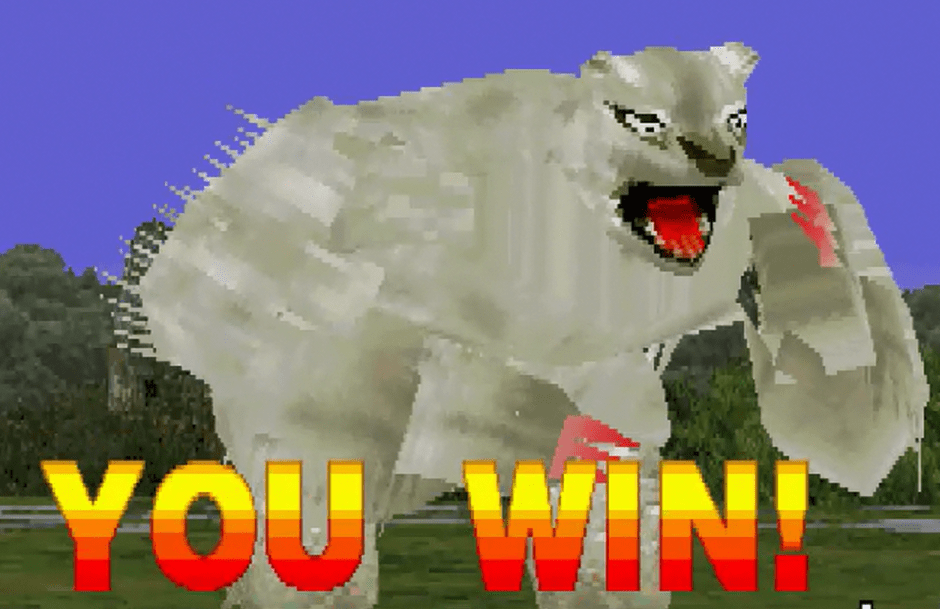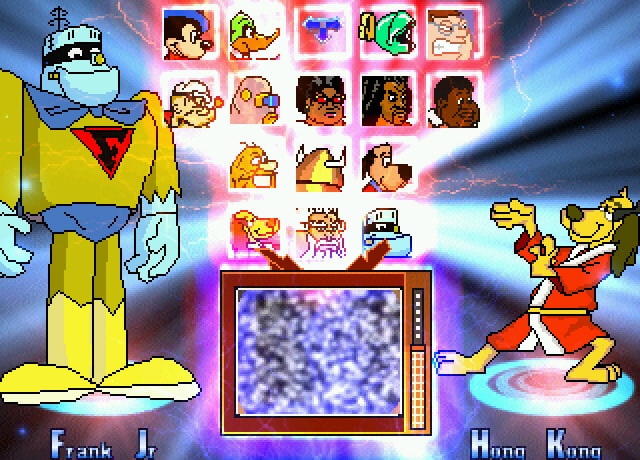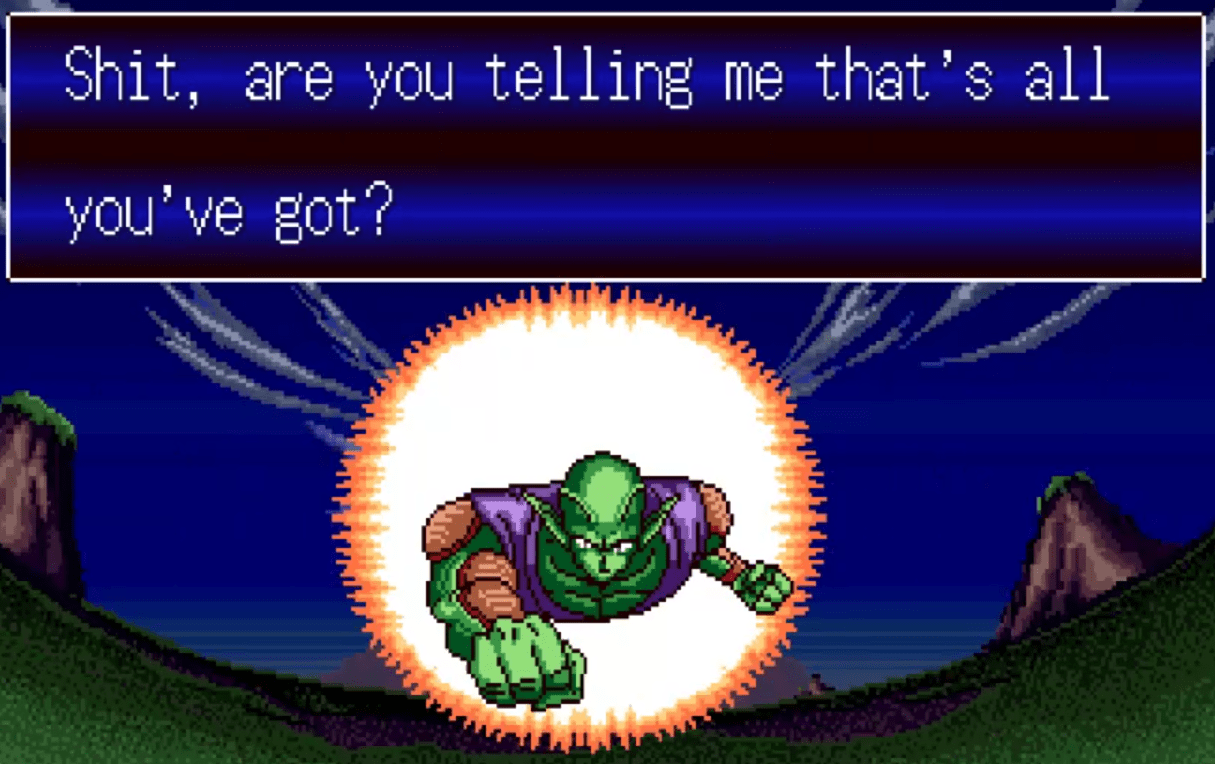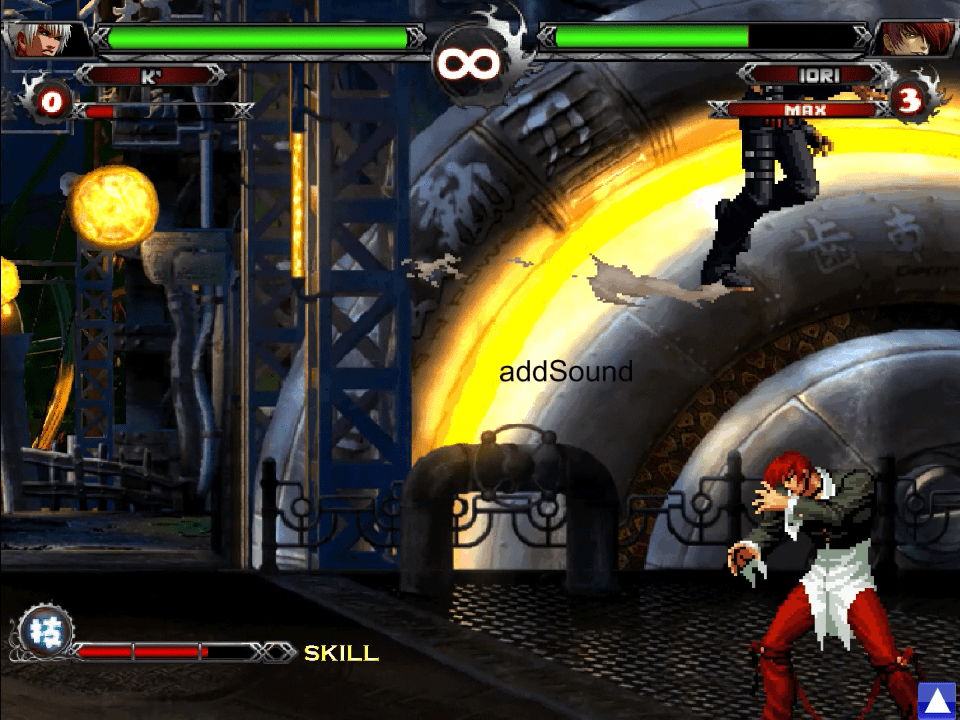Kusoge Advent Calendar 2017: Week One
“Kusoge” (糞ゲー, or クソゲー) is a Japanese compound word - “kuso”, meaning “garbage, crap, shit”, and “ge”, short for “geemu”, the Japanese pronounciation of the word “game”. It means, quite literally, “shit game”. —HardcoreGaming101
Fighting games have a pretty wild history. Like any genre, the false starts and failed attempts vastly outnumber the games that “made it”. Sometimes, those forgotten failures carry bizzare and beautiful ideas with them to the grave. Sometimes, they’re trash fires with no redeeming qualities. Either way, if you approach it with the right mindset and protective gloves, diving into the dumpster can yield some…interesting results.
I’m TyroneSama. In December of 2016, I played 25 different shitty fighting games, one for every day until Christmas. A year later, because I am a stupid asshole and I hate myself, I decided to do it again.
I assembled four trusted associates, kusoge experts of the highest caliber: Zari0t, Keegan, Abbock and Sleepmode. They were asked to put together 25 of the most incomprehensibly fucked-up fighting games they could name. No screenshots, no explanations, only names and instructions. I would know nothing about the lineup until I played each game.
I could spend some time introducing these gentlemen to you, reminiscing over the awful games that brought us together, but we’ve got too much to cover here. Instead, please enjoy the results of this short questionnaire:
Q: What’s your favorite normal in a fighting game?
Zari0t: Sakuya 6A.
Keegan: Daimon far st. B. The Button.
Abbock: GNT4 Temari JB
Sleepmode: Rash 5HK in Killer Instinct
Q: What’s the most upsetting thing a game has ever put you through?
Zari0t: Sakuya 6A.
Keegan: I’ve played multiple 3D Sonic games. Don’t ask questions you aren’t prepared to handle the answers to.
Abbock: The final chapter and ending of Drakengard
Sleepmode: The entirety of Death Cargo
Q: Do you feel the need to apologize?
Zari0t: Absolutely not.
Keegan: Yes, but I refuse to.
Abbock: No. I wouldn’t expect forgiveness anyway.
Sleepmode: I am beyond redemption
Christmas is all about the spirit of giving—these four gave me temporary hearing damage, permanent trust issues, and some profoundly bizzare experiences I’ll never forget. I asked for garbage, and they delivered in ways I wasn’t prepared to handle; I can only hope that my outraged, stupefied disbelief is a suitable gift in return.
Extra special thanks to Freyaday, my partner and sounding board of 6 years, for putting up with me during the month of December. Fighting games are best with buddies, so I dragged him into a handful of these games, and his perspective as a scrublet was just as important as his moral support.
Now let’s play some kusoge.
#1: Tekken
Last year, we started the Advent Calendar with Guilty Gear: The First One, and discovered the wonders of Grand Viper infinites and two-round Instant Kills. This year, we started with Tekken: The First One. In a lot of ways, it feels like coming home.

Tekken is one of those games that makes me wonder how fighting games ever got popular. It’s like an insect frozen in amber, more of an archaeological artifact than a functioning video game. It’s got that very particular Early Fighting Game Feel, where pressing buttons is so stiff and committal that it feels better to do nothing at all—the lack of sidesteps doesn’t help. Basic strings require sadistic precison, since there’s no input buffer, but that’s okay; connect with a launcher or a hopkick and your opponent loses 50% life on the spot. Minimum. Oh, and the cast is even smaller than it looks, since half of the playable characters are clones of the other half.
This game doesn’t want to be looked at. The characters barely look human—that much is obvious—but spend a few hours with Tekken and the rest of the package starts to sink in. Nauseating, feverish texture jitter graces the tiled stages, like the ground is shifting under the characters' low-poly feet. The pre-rendered character assets all have these bizzare, animatronic facial features that slide way too far. Every piece of text is drawn with a different banded WordArt gradient. My gaze slowly slid off the screen in protest; keeping it on the game was a physical effort.
If there is any value left in the original Tekken, it’s for series historians or esoteric lab-monsters. Everyone else can stay away. You’re not missing anything—except the greatest ending cutscene in fighting game history.
VERDICT: ASS
Zari0t: It’s incredible to me how this ended up being the beginning of one of the most popular fighting game franchises of all time. Like holy shit, it looks SO BAD and it plays even worse. But it was the start of something new, something different, something…3D. It just goes to show that even the biggest of names have the roughest of starts. Long Live The Deathfist.
Sleepmode: Did you know Heihachi’s jab links both into itself and his launching df+1,2? Cool game.
#2: Saturday Mornin' Mayhem
Day 2’s game is a one-man project, and the man behind it all is Derrick D. Rowell. Before we go any further, I’m going to be honest; nothing I write here can compare to the experience of exploring Rowell’s personal site. There’s a lot there, and I encourage you to look around, but please at least click the link and look at the first page. I’ll be here when you get back.

Derrick Rowell is the only person on the entire planet who could look at the cartoon superhero Underdog, one of the shittiest characters in the history of American broadcast television, and say “Yeah, I’m gonna recreate this guy in MUGEN and he’s gonna play like Marvel 2 Storm.” That’s not a thought that can happen to normal people. It’s definitely not a thought that can happen 15 additional times, with both characters replaced Mad-Libs style each time, but somehow the Saturday Mornin' Mayhem cast exists anyway, a place where Captain Caveman and bootleg Sentinel can fight Hercules' Zeus and Duck Dodgers, a towering monument to dogged persistence in the face of reason and good taste.
Anyway, Saturday Mornin' Mayhem is a MUGEN game, because everyone involved in game selection wanted me to fucking die. If aliens came to Earth with knowledge of only mahvel baybee! and Cartoon Network’s Boomerang, their first transmission might look a lot like Saturday Mornin' Mayhem: airdashes, superjumps, a 5-bar super meter, and a whole bunch of deafening, barely-recognizable cartoon noises churned through countless layers of compression.
I have a lot of respect for the amount of work that goes into something like this. No matter your level of skill, scripting and spriting a cast of this size isn’t easy; it’s often a crushing workload even for experienced teams, and for a single developer, completing a project of this scale is seriously impressive. With that said, absolutely everything about this game is offensive to every sense simultaneously. It is hot fucking garbage. It is broken in ways that cannot be fixed by mortal hands. If you love fighting games, I guarantee you will hate Saturday Mornin' Mayhem.
VERDICT: ASS
Zari0t: My introduction to the fighting game genre was, not surprisingly, the age-old perfection that is MUGEN EvE - Everything vs Everything. Fat Albert was in it and I had no clue where it was from, but I distinctly remembered the character existing. Fast-forward nearly ten years and, lo and behold, a friend of mine shows me this game. I felt more than obligated to include it into the list. I was actually as blind as AJ was on this one - my only prior exposure to it was that JIYUNA IS
#3: Asuka 120% BURNING Fest Final
Asuka 120% has a long history. Since its birth on Fujitsu’s “FM Towns” PC, it’s received ten updated rereleases by five different developers, somehow finding its way to the Saturn, PlayStation, and Windows 98. As far as I can tell, BURNING Fest Final is the last of them, with 8 years between it and the original. I found an infinite in my first and only session.
This is a great game for fighting game veterans to play with newbies, because mashing is stronger in Asuka 120% than any other fighting game in human history. Every normal comes out at the speed of light, and if it goes anywhere near another attack, it’ll clash and reset both players to neutral—where they can mash out another attack. It’s like bishoujo Dragon Ball, plasma-chucking included.
Asuka 120% was a welcome break from the uncontrollable trash fires that came before it. The spritework is solid, movement feels fun, and Keishi Yonao’s music is a great example of early CD audio done right, with delicious layered synths and punchy, uptempo drums throughout—though I’m a sucker for the earlier FM versions. The aesthetic might not be for everyone, but it’s clearly made with care.
Despite that, Asuka 120% resisted all my attempts to actually understand it. Everything is designed to coax you into churning butter on the input device of your choice, whether it’s the meter mechanics, the juggle system, jump arcs and fireball properties…try applying standard fighting game knowledge and everything just slides off, lost in a blur of rapid clashes. “Just run up to your opponent and mash,” Asuka whispered in my ear. “It’ll be fun. You know it’ll be fun. How long has it been since you just slammed your entire hand on all 8 buttons like a fucking gorilla? Don’t you miss that?”
I gave in. It was pretty fun.
VERDICT: REAL-ASS
Keegan: The first version of this game I played was actually not this one, but Asuka 120% Burning FestLimitOver for the Saturn. It seems to feature the same characters and similar systems, apart from lacking the “down” system. The sheer insane pace, miniscule damage, and mad clashing still exists. What doesn’t exist, however, is any sort of proper menu; it’s entirely just Japanese text on a black background, there’s no story or arcade mode, just survival and versus. I don’t even remember if it had training. Word on the ‘net is that LimitOver, which mostly serves as a balance update for an earlier Saturn release, Burning Fest Limited, was hacked together by the original team after their studio went out of business and then distributed at conventions. Or maybe it’s just a fan hack. Kusoge history is tough work, after all.
Freyaday: This is an interesting beast. People who at least somewhat knew what they were doing put heart and soul into this thing, and you can feel it in the end result.
It’s just a shame that the end result has about as much competitive value as Mario Party: The Top 100. From a guy who doesn’t know shit about fighting games, this is one of the mashiest ever produced, second, perhaps, to the original Street Fighter cabs that wanted you to physically punch the buttons with your fists. There’s still something to that; maybe grab a mate and a $socially_approved_drug and laugh your asses off playing the first beta of Dead or Alive Volleyball, but it’s not a must-have experience.
Zari0t: I unironically want to play this game.
#4: Mortal Kombat - Deadly Alliance
What surprised me most about Mortal Kombat - Deadly Alliance was the way it ended. Until I saw the credits, it hadn’t even occurred to me that multiple people could be complicit in its creation—it’s just one of those things you never think about. It’s been 13 years since the game released. I wonder where the developers of Deadly Alliance are now. I hope they’re okay.
There are two versions of Deadly Alliance; one for GBA, and one for PS2. I don’t know much about the PS2 version, but from what I know, it would have been a perfect fit for the list. Apparently that would have made too much sense, because I ended up with the GBA version instead, and it’s got all the classic hallmarks of the platform:
- 15 FPS
- 3 to 8 heavily compressed voice lines
- Completely uncontrollable movement
- Input sampling that just doesn’t give a fuck
- Flickery, vertigo-inducing fake 3D
- Things that look like infinites, not that I’d ever enlist another human to test
I have almost nothing to say about Deadly Alliance because there’s almost no gameplay to comment on. You awkwardly rub against your opponent’s blur of incorrectly-scaled pixels, hitting attack buttons in hopes of doing anything that decreases their life bar. No game state is meaningfully distinct from any other. It’s plastic fruit in fighting game form, hollow and inedible.
Even the fake single-player content, usually Mortal Kombat’s strength, is a tragedy. I fished a palette called “Anime Scorpion” out of The Krypt, rushed to character select to try it out, and discovered it was just normal Scorpion with the saturation slider raised slightly. I got mad. Anime Scorpion was my last hope for finding some value in this nonstop trainwreck, and it somehow had less effort put into it than the rest of the game.
Every remaining physical copy of this game should be collected and jettisoned to space. If an alien civilization comes across what remains, they will know to stay as far away from our solar system as possible. I am done writing about this.
VERDICT: ASS
Sleepmode: I once attempted to write a theoretical rebalance of the console version of this game. I kept dropping it and coming back to it, at once frustrated at the ineptitude of its character toolset design and absolutely fascinated with just how… weird it was. That is until I realised that one of the ways in which this game was different involved crouch jabs being lows, jabs being mids and the entire concept of special mid straight up not existing.
Then I remembered the GBA had a version of MKDA.
The console version of MKDA is completely insane, but its rules can at least be parsed through common fighting game knowledge to a degree. Whatever rules you think apply to this game – they probably don’t. Likely because this game just doesn’t have any rules.Fun fact: there were two versions of this game, with each offering different characters – this game’s counterpart is called Mortal Kombat Tournament Edition. Seems really funny in hindsight.
#5: One Second Galaxy Fight
To talk about One Second Galaxy Fight, we have to talk about Galaxy Fight, which is an entirely different thing.
Galaxy Fight is Sunsoft’s first attempt at a fighting game. It’s a relic of a time where we, as a society, sort of knew how to make fighting games, but were still trying to figure out which of the implicit rules were optional—things like “DPs should travel primarily upward”, “you stop dashing by releasing the stick”, or “stages should have corners”. Earnest and charming, but undeniably clumsy.
The whole game is centered around dashing. Jumps are slow and floaty, but they carry momentum from a dash, crossing the screen in a single bound. Attacks work the same way, extending the range of ground normals and creating some pretty stupid-looking DPs. Eat a heavy hit, and you’ll get knocked back a screen or two before eating dirt—and when you get up, what better way to close the distance than a dash? The concept is neat, but the end result feels a bit clumsy, with disorienting camera logic and some bizzare aerial play. You spend a lot of time soaring past or dashing under your opponents.
The fun starts when you dive into the Neo Geo operator menu—if you’re paying attention, you’ll notice that the round timer’s a little strange. Instead of your typical 30/60/90/off, it lets you choose any number between 1 and 99.
One Second Galaxy Fight is a better simplified fighting game than Fantasy Strike, Divekick, and Señor Footsies combined.
Set the round timer to 1, and the unorthodox movement suddenly transforms, hitting the perfect balance of heavy commitment and high flexibility. Every floaty moonjump becomes a balls-out death gambit, and to catch a backdash before the round ends you’ve gotta gun it full speed ahead. It’s 10 times more fun than the standard game, and while it’s probably hilariously broken, I’m keeping my head in the sand on that one.
Somehow, this turned into one of my favorite games of the calendar. Maybe I’ll make it a Christmas tradition.
VERDICT: REAL-ASS
Zari0t: Now THIS I was expecting to get a Real rating. It’s incredible what shortening a round timer to such low values can do to a game’s pacing. More games should let you do things like these, let the players experiment with everything and just see what it would feel like - who knows, you might just find the next big thing to do at a-cho freeplay days. #FreeBonusKun
Keegan: I’m still thoroughly angry that 90% of G. Done’s options in this mode are shut down by Roomi’s jumping B. [Author’s note: stay free]
#6: Dragon Ball Z 2 Super Battle
Every Kusoge Advent Calendar has to have a shitty Dragon Ball game. It’s the rule. Fortunately(?) for us, there’s enough of a backlog to cover the next 25 years, and they still haven’t stopped making more. They are never going to stop making more.

For the first 20 minutes of this stream, I thought the game was emulating at the wrong speed, or that I’d grazed the fast-forward hotkey by mistake. You can whiff normals 15 times a second, and jumps are so fast that they’re practically divekicks. It’s like a photo negative of Galaxy Fight, right down to the visuals—going from meticulous spritework to posterized photo backgrounds is a motherfucker of a transition.
The ludicrous speed extends to every aspect of the game…except for projectiles. Super Battle is the only DBZ game I’ve played where ranged attacks are flat-out garbage. They start up slow and recover even slower, to the point where I suspect most of them are punishable on hit. I’ll have to go back later and test, because I never managed to hit the AI with a fireball anyway.
The one worthwhile gimmick I noticed was the flying screen. Certain attacks launch both combatants into the air or slam them back down to the ground, which is a nice DBZ-flavored touch, but air combat is exactly the same as ground combat besides fucking up your crouch. It’s kind of weird to see floating characters using grounded jump arcs, but it’s honestly no weirder than anything else in Super Battle.
After an exhausting hour of trying to crack the computer, which routinely sat in the corner and flawlessly defended for minutes at a time, I eventually found a loop where they got stuck blocking specials…which deal more damage on block than they do on hit. I’d love to test out the systems with another human player, but knowingly subjecting someone to this game is probably immoral.
VERDICT: ASS
Keegan: The choice of the coveted Dragon Ball Z spot on this year’s list was a hotly contested one. As it turns out, there have been a LOT of bad Dragon Ball Z fighting games. Other choices for this year included DBZ Ultimate Battle 22, DBZ Hyper Dimension, DBZ Buyuu Retsuden, and Dragonball Evolution (yes, that movie got a game!). But somehow, as soon as I saw those jump arcs, I knew Super Battle was the one.
#7: The King of Fighters WING EX
Flash game. 30 FPS. More input delay than SF5 on a bad TV. And, like seemingly every amateur project to grace my screen in December, unimaginably fucking loud.
Apart from those gripes, though, WING EX is almost a competent fangame—if it didn’t feel like wading through molasses to play, it might have even been fun. Sure, there’s an Armor Mode install, and you can airwalk by chaining into command normals after a DP, and there’s a one-move infinite if you know how to delay rekkas, and you can softlock the game with no obvious source…okay, it’s pretty bad, but at least it seems to follow normal fighting game rules 80% of the time. It’s obviously technically broken, but the design problems take a little exploration to work out. That’s more than I can say for a lot of games on this list.
If nothing else, this game deserves an award for the number of assets it manages to steal. It doesn’t stop at ripping from King of Fighters; WING EX borrows sprites from Melty Blood, characters from Street Fighter and Samurai Shodown, sound effects from Guilty Gear, and stage backgrounds from…Umineko: Golden Fantasia? Don’t worry, though, they’re all sourced in the credits: “Graphics from the Internet.”

There’s a charming sort of honesty here. The opening title includes an unskippable warning—the standard “If you paid for this, you have been scammed”—but tacks on a little extra disclaimer, reminding everyone that Chun-Li is not from King of Fighters, and imploring them to stop asking about the Samurai Shodown cameo. There’s some help text in the menus explaining how to restart the round when the game softlocks, and the fact that exists at all is almost endearing. I dunno, maybe it’s a little disingenuous for me to cut this so much slack while lambasting Saturday Mornin’ Mayhem, but a little self-awareness and humanity goes a long way. If I’d played this in 2008, middle-school me would have fucking loved it.
Oh, it released in 2014. Okay then.
VERDICT: ASS
Sleepmode: This has been a long-running project by Flashwing for a while now, but I’m pretty sure that it’s dead (thankfully). I discovered the original versions of KOF WING on those random flash game websites when I was a kid – in the earlier versions of the game, they forgot to program in invincibility after air resets, so there were mega dumb 5A into whatever corner loops for days. What really drew me to this game (aside from its raw kusoge potential) was the fact that it was the most competently made fighting game made in flash I had ever come across, with a developer that seemed to at least have some basic understanding of the genre.
Then again, you can make K’s running sound object visible, and completely shut down the AI just by throwing fireballs like it’s vanilla Injustice Deathstroke.
Keegan: Well, it’s less broken than at least one official KOF game.
It took me a long time to organize my thoughts after the end of December. Every one of these games, along with the 18 games still to come, is a beautiful cultural katamari, even if the game itself is total garbage. I’ll never get tired of wandering through fighting game history, examining the missteps and dead ends, the orphaned oddities buried under the latest Capcom release.
That’s after a month to reflect, looking back at December with misty eyes. At the time, a week into the marathon, I was legitimately nervous. The list had been through countless revisions and reorderings, optimized for impact—if this was week one material, worse than almost anything in last year’s lineup, what the fuck was coming next?